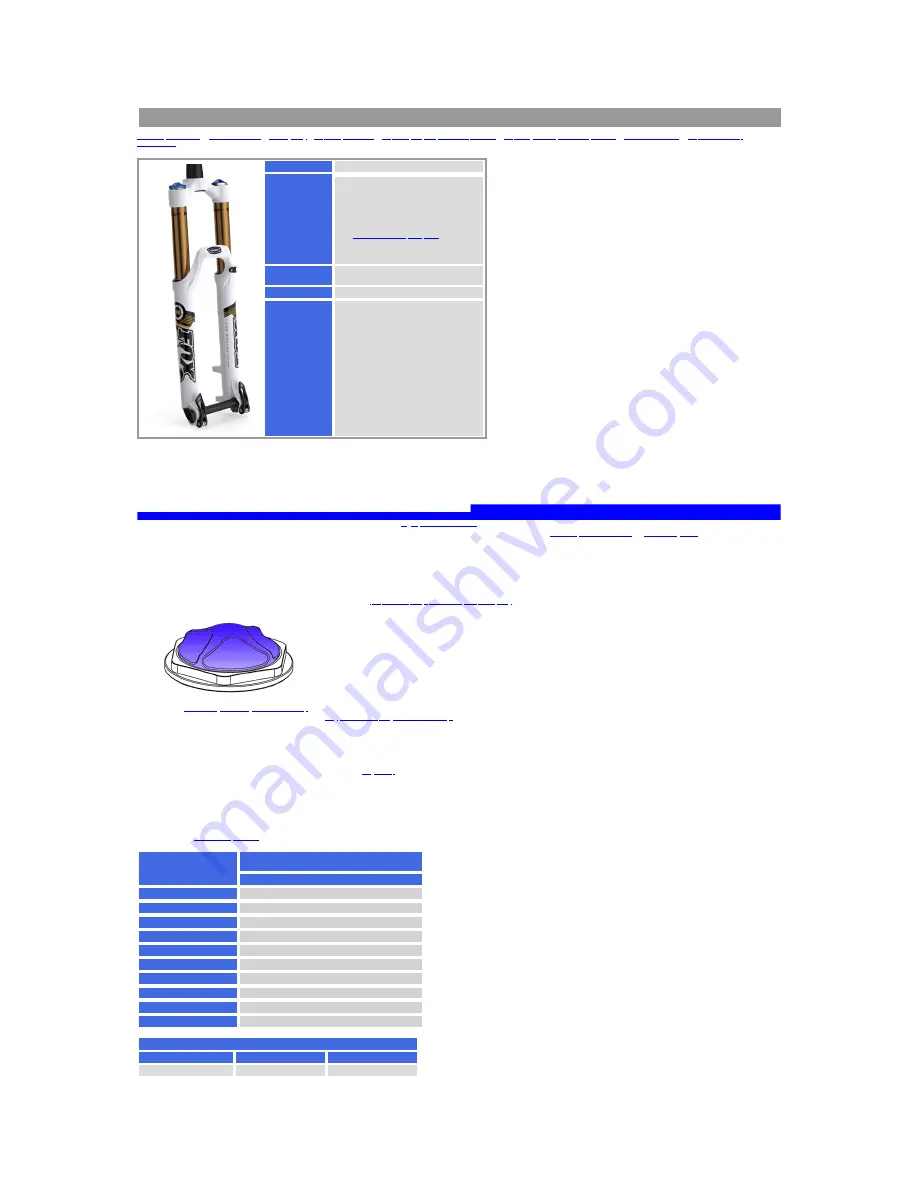
36 FLOAT 160
Before You Ride
|
Setting Sag
|
Adjusting Rebound
|
Adjusting High Speed Compression
|
Adjusting Low-Speed Compression
|
Service Intervals
|
travel
•
6.3 in./160 mm
model
features,
adjustments
Factory FIT RC2; 160
: Kashima
coated or hard anodized upper tubes,
1.5" tapered or 1 1/8" steerer, low-
speed compression, high-speed
compression, air spring pressure,
rebound.
: Hard
anodized upper tubes, 1.5" tapered or
1 1/8" steerer, air spring pressure,
rebound.
lower leg
20QR thru axle system, post style disc
brake mounting
spring
air
riding styles
AM, FR
Installing Your Fork
Be sure your fork is properly installed before proceeding. If your fork came pre-installed on your bicycle, continue to the next section.
Before You Ride
1. Check that your 20 mm axle pinch bolts and crown pinch bolts are properly adjusted and tightened.
2. Clean the outside of your fork with only mild soap and water, and wipe dry with a soft dry rag.
NOTE:
Do not use any solvents or de-greasers, as these products can cause serious
damage to paint and anodized parts (upper tubes, knobs, steerers).
Do not spray water directly on the seal/upper tube junction.
Do not use a
on your fork.
3. Inspect the entire exterior of your fork. The fork should not be used if any of the exterior parts appear to be damaged.
for further inspection
and repair.
4. Check your headset adjustment. If loose, adjust it accordingly to your bicycle manufacturer's recommendations.
5. Check that all brake cables or hoses are properly fastened.
6. Test the proper operation of your front and rear brakes on level ground.
Setting Sag
To get the best performance from your fork, it is necessary to set the
proper air spring pressure by adjusting sag
. Generally, sag should be set to 15 – 25% of total fork travel.
1. Unscrew the blue aircap on top of the left fork leg to expose the Schrader valve.
2. Attach a
FOX Racing Shox High Pressure Pump
to the Schrader valve.
3. Pump your fork to the appropriate setting from the
Suggested Air Spring Pressure Settings
table below, then remove the pump.
4. Unless your fork already has a sag setting o-ring on an upper tube, install a zip tie to an upper tube. Slide the o-ring or the zip tie down against the scraper lip of the fork dust seal.
5. Make sure the low-speed compression is open (fully counter-clockwise out).
6. Dressed to ride, position your bike next to a wall or table to support yourself. Without bouncing, mount your bicycle. Assume a normal riding position for at least 30 seconds, allowing the
suspension to fully settle.
7. Dismount your bike without bouncing downward, without further moving the o-ring or zip tie. Measure the distance between the seal and the zip tie. This measurement is your sag value.
8. Compare your actual sag value to your target sag value in the
Sag Setup
table below.
If your sag measurement value is less than the Sag Setup table value
, screw on the pump
fi
tting, note the current air pressure setting and depress the black bleed-valve to reduce the
gauge pressure by 5 psi. Measure sag again and repeat this adjustment, if necessary.
If your sag measurement value is greater than the Sag Setup table value
, screw on the pump
fi
tting, note the current air pressure setting and pump to increase the gauge pressure by 5
psi. Measure sag again and repeat this adjustment if necessary.
9. Screw the blue aircap back on.
10. Check your
rebound adjustment
; adjust it if necessary.
11. Rider
Weight
lbs.
12. Suggested Air Spring Pressure Settings
13. PSI
14. 160 mm
15.
≤
125
16. 45
17. 125 - 135
18. 45
19. 135 - 145
20. 50
21. 145 - 155
22. 55
23. 155 - 170
24. 60
25. 170 - 185
26. 65
27. 185 - 200
28. 70
29. 200 - 215
30. 75
31. 215 - 230
32. 80
33. 230 -
≥
250
34. 85
35.
36.
Sag Setup
37. Travel
38. XC
39. All-Mountain
40. 160 mm (6.30")
41. 24 mm (0.94")
42. 40 mm (1.57")




